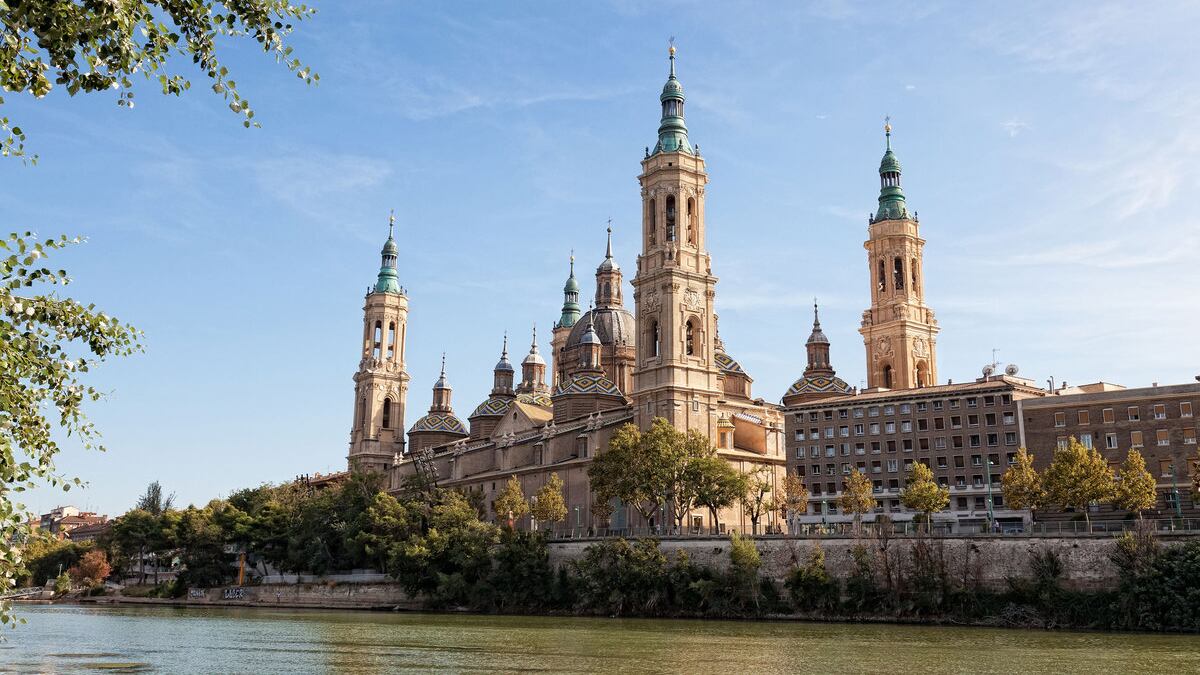This is the latest edition of our series on underrated destinations, It's Still a Big World.
It’s not what you might call “off the beaten path.” Glance at any map of Spain and you won’t take long to find it, poised at the mid-point between Madrid and Barcelona and between the country's Cantabrian and Mediterranean coasts. Both by road and rail, it’s well-connected. And a river runs through it—the mighty Ebro, Spain’s answer to the Rhine or Volga.
Which makes it all the more remarkable that even after 32 years of life in Spain, until quite recently I’d never once set foot in the place. The remote Atlantic island of El Hierro, the Coast of Death in Galicia’s northwest corner, the peaks of Gredos and the lagoons of Daimiel—all of these I had explored and written about at one time or other. But three decades later Zaragoza still hovered in the upper reaches of my bucket list.
When lockdown lifted and my wanderlust returned, it seemed that now might be a good moment to remove it from the list altogether.
In the days before I was due to travel I canvassed Spanish contacts about my upcoming trip. Zaragoza, they told me, was home to Our Lady of the Pillar, Catholic patroness of Spain and the Hispanic world in general. The locals—many of whose names were Pilar—liked to sing and dance in a traditional genre known as la jota. They had a reputation for pride and obstinacy, but also for generosity and good humor.
“They like to eat well. They also like to drink well,” smirked one friend.
Despite being a major logistical and industrial hub, Zaragoza was said to be an easygoing city with a provincial, almost small-town vibe. I felt my expectations rising. Just maybe, this would be somewhere that had managed to avoid the over-tourism plaguing certain other Spanish cities (hello Barcelona) and had remained, in that deathless travel cliché, “under the radar.”
The 75-minute journey on the high-speed AVE train from Madrid was such a short, smooth, and uneventful ride, it barely seemed enough to make this feel like a proper adventure.
As the landscape of northeastern Spain rushed by—barren, craggy peaks, deep valleys with almond plantations in their depths, picturesquely ruined villages laid waste during the Civil War—I wondered how Zaragoza could have slipped from my grasp for so long. It was almost as if I'd been saving it up for later, maintaining my ignorance in order to fully enjoy the learning process when it finally kicked in.
One thing I'd always known was that Aragón, the region of which Zaragoza is the capital, has a deep seam of history and culture. At its 14th-century height the Aragonese empire stretched over most of the western Mediterranean, with outposts in Sicily, southern France, and the Balearic Islands. Aragonese bankers largely financed Columbus’ transatlantic endeavors. Over the centuries the region has brought forth a slew of important artists (Goya, Gargallo), film directors (Buñuel, Saura), scientists (Ramón y Cajal, Miguel Servet) and at least one great choreographer (Victor Ullate). Nowadays, among Spanish cities, Zaragoza takes fifth place for population and economic clout yet ranks a poor 14 in terms of visitor numbers—way down there with Adeje and San Bartolomé de Tirajana. (Where are they, anyway?)
I'd made sure to choose my travel dates with care. October 12th is a Spanish national holiday and the feast-day of the Pillar, when Zaragoza erupts into a week-long fiesta in which the sensible rhythms of daily life come to a juddering, wine-soaked halt. Planning my visit for the week before the big day, I calculated, would give me a blast of pre-party excitement without sweeping me up completely in the madness.

Aragon, Spain.
Andrea Comi/Getty ImagesSo it was that one morning at the start of October I found myself, breathless after the steep climb, at the top of a spire crowning the Basilica of the Pillar.
From this vantage point, getting your bearings was a breeze. The city lay on a bend of the Ebro river, which meandered across a fertile plain between low hills that were bare and dust-coloured, giving the look of an oasis in the desert. Far below me lay Plaza del Pilar, said to be the largest public space in Europe after Moscow’s Red Square with, at the far end, the medieval Seo (Cathedral) and its graceful round cimborrio tower. The roofs and squares of the old town were corralled into a neat rectangular shape abutting the river, while a new town of modern apartment blocks on the opposite bank quickly petered out into wooded countryside. In the distance I could just make out the sinuous metallic form of Zaha Hadid's pavilion/bridge over the Ebro, designed for the Universal Exhibition of 2008.
At street level I strolled the square, marveling at the scale and grandeur of the buildings surrounding it in a panoply of architectural styles: the Gothic Seo, the Renaissance Lonja (exchange), and the Baroque Basilica whose forest of towers and domes adorned with multicolored tiles gave off a fantastical, almost Disney-ish vibe. At this late hour of the morning the terrace tables of the Plaza were humming with locals taking the day’s first cañas of beer or glasses of red wine along with a croqueta or two, a saucerful of green olives, or a plateful of air-cured Teruel ham.
My wanderings over the next few days would show me a city whose pleasing logic, cultural coherence, and quality of life were new to me. For a city of 675,000 people it was surprisingly manageable; most everything worth seeing lay within walking distance. There were parks and gardens with splashing fountains like the Parque Grande, and pretty squares with terrazas in the shade of plane trees. One day I walked along the riverbank to the site of the 2008 EXPO, a high point of Zaragoza’s recent history and still worth visiting for Europe’s biggest freshwater aquarium and Zaha Hadid’s famous twisty bridge.
True, the retail universe on the wide shopping streets, calles Alfonso and Don Jaime, were monopolized by the same tedious chain-store brands you find in every Spanish city. The few traditional stores that had survived gave a far more genuine and eccentric flavor. The century-old pastry-shop Fantoba, with its creaky colonial-themed wooden interior, still sold the specialty Frutas de Aragón (glacé pears, cherries, and apricots, all dipped in dark chocolate). There were cheese shops and ancient bakeries, old-fashioned tailors, and specialist jewelers like Aladrén, where zaragozana ladies buy trinkets to wear for the Offering to the Virgin on October 12th.

The Tubo, a labyrinth of old-town streets full of bars and restaurants.
sinclair_JVZ via ShutterstockAnd, quite naturally, there was a market. The Mercado Central, a monumental structure in brick, iron and glass, its soaring arches and pseudo-Moorish stylings giving it the air of a steam-era railway station, was where I began my apprenticeship in iconic local products like the milk-fed ternasco lamb, the juicy peaches from Calanda, and the borage leaves—a sign of Aragonese culinary identity if ever there was one, served throughout the year in bubbling casseroles of rice, salt cod, and potatoes. A fondness for offal was clearly a thing around here: one particular class of market stall specialized in pig’s ears, calves’ heads sliced in two like melons, and the alarming madeja—essentially a length of lamb’s intestine wound around a leek, to be char-grilled or oven-baked with garlic and parsley.
Food and wine are major determinants in the lifestyle of any Spanish city, and Zaragoza was no exception. The restaurant genres here ran the gamut from high-end to humble, but it was local cuisine—rather than fancy food fashions from beyond the region—that plainly ruled the roost. There was huge fun to be had in the so-called Tubo, a labyrinth of old-town streets where everybody heads for tapas crawls among bars and taverns each of which has its own speciality—mushrooms at El Champi, croquetas at Doña Casta, anchovies every which way at Bodegas Almau—and the atmosphere takes on a rambunctious note as the wine-toting crowds pack the alleys on a big fiesta night.
The places I liked best were sedate family-run establishments like La Rinconada de Lorenzo, a Zaragoza classic where the Navascués family had been nursing their reputation for ternasco and rabbit en escabeche since the restaurant was founded half a century ago. At Casa Montal, a historic deli and wine store dating from 1919, I sat in the first floor dining-room overlooking a columned patio and María Montal, fourth generation of the family, brought me cheese-stuffed artichoke hearts and migas (fried breadcrumbs) with longaniza sausage and fresh grapes. With this lunch Maria served a velvety red from the much-loved local Garnacha variety, plucked from the encyclopedic selection of Aragonese wines in the downstairs cellar.
Culturally as well as gastronomically, the city offered a diversity that was rich and copious but easily digestible. It had museums and monuments dating from every era of Zaragoza’s 2000+-year history; churches with a haunting Islamic influence, a Roman theater, and a Moorish palace, the Aljafería, like a modest version of the Alhambra with orange trees and fountains in decorated courtyards. The Cathedral museum had a stunning collection of Renaissance tapestries, of incalculable value and beauty. If in the 16th century Zaragoza was described as the Florence of Spain it was thanks to the number and magnificence of its aristocratic mansions – one of which now houses the world’s largest collection of work by the genial Aragonese sculptor Pablo Gargallo (1881-1934).
But among Zaragoza’s various art museums in old-town palaces there was one sure-fire, drop-dead winner.

View of the roofs and spires of basilica of Our Lady in Zaragoza, Spain.
Anton Petrus/Getty ImagesThough his relationship with his hometown was not always an easy one, nowadays Francisco de Goya is held by zaragozanos to be a universal brand ambassador for their city. The Museo Goya is touted as the one place in the world in which all the great man's grabados (engravings) are displayed under one roof.
I'd loved Goya for years but was unprepared for the impact of his Desastres de la Guerra, a series of engravings based on the brutal siege of Zaragoza by Napoleon's armies in 1810-1815. The scenes of horror and anguish, rendered at times with an almost photographic crudity, made me wonder if any artist before him had considered so closely the effect of war on human beings. One of the 82 engravings, Estragos de la Guerra, showed a tangle of arms and legs in a scene of violent chaos uncannily prefiguring Picasso's Guernica. In the unflinching bleakness of his vision, Goya seemed to reach out from the early 19th century into the tumultuous beginning of the 21st.
****
This trip had been all about closing the gaps in my experience–but there was one important box that had yet to be ticked. I still hadn’t had my up-close encounter with Our Lady of the Pillar.
On the morning of my last day in town I headed back to the great Plaza del Pilar, feeling more than ever how it pulls all urban life towards it with a magnetic, centripetal force. Over my visit it seemed there had always been something going on here: a concert, a demonstration, a folklore display, or a military passing-out ceremony with flags and uniforms and the square echoing with the sound of brass bands. Late at night it was silent and empty like a vast deserted drawing-room.
Now I snuck into the Basilica along with a crowd heading for the gold-slathered chapel at the heart of the building. This was the Holy of Holies, and that was Nuestra Señora del Pilar. She was a carved wooden figure little more than the size of your hand, rough-textured like a stick found on the forest floor, the very plainness of the image contrasting fiercely with the glittering rays of her halo, her mantle in rich fabrics, and the folds and furbelows of the High Baroque architecture all around her.
I spoke to a man who was admiring Our Lady from a back row of the chapel. “For us she’s like one of the family,” he whispered.
Along the Calle Alfonso local women and their daughters were to be seen peering into the windows of haberdasher’s shops in search of the silk sashes, the rush-soled espadrilles, the ornamental combs, to accompany their traditional outfits on the big day. After two years in which the pandemic had been a party-pooper, word was that this year’s fiestas del Pilar would be a bigger deal than ever. I of course would be watching the show at home on Aragon TV—half-glad to have avoided the crush, half-wishing I was there to witness the swirling skirts and fancy footwork of the jota, the men in cummerbunds and white cotton breeches, the merry tapas crawls through the alleys of the Tubo.
I left Zaragoza just as everyone else was just arriving. The city was visibly filling up—but these were Aragonese from the neighboring provinces of Teruel and Huesca, curious Spaniards, and true believers from around the Catholic world, not tourist hordes.
My initial hunch that this wasn’t a city with a problem of over-tourism had proved correct. A steady stream of French visitors had begun arriving over the Pyrenees. The English and the Germans were coming in dribs and drabs, but they were looking for culture and cuisine. The tchotchke shops were few and far between. For the moment Zaragoza was still pursuing its placid routines in the same good-natured way, unaltered by the distorting fairground mirror of tourism.
The lady in the café with the neatly coiffed gray hair didn’t look like a tourist, even if she did ask me to take a picture with her beside a tray of golden churros.

The North Entrance of the Zaragoza Bridge Pavilion at the 2008 Expo in Zaragoza.
View Pictures/Universal Images Group via Getty ImagesIn fact she was a zaragozana who’d come in from the suburbs to check out the atmosphere in town with just 48 hours to go before the Fiestas de Nuestra Señora del Pilar.
She and I sat at neighboring tables and I snaffled a plate of crisp churros—a farewell treat to myself before heading for the station.
“Well then, I’ve had my breakfast,” announced the zaragozana, gathering up her things as she rose to leave. She primped her hair and checked her makeup in a little mirror. “Now I’m off to see the Virgin.”






